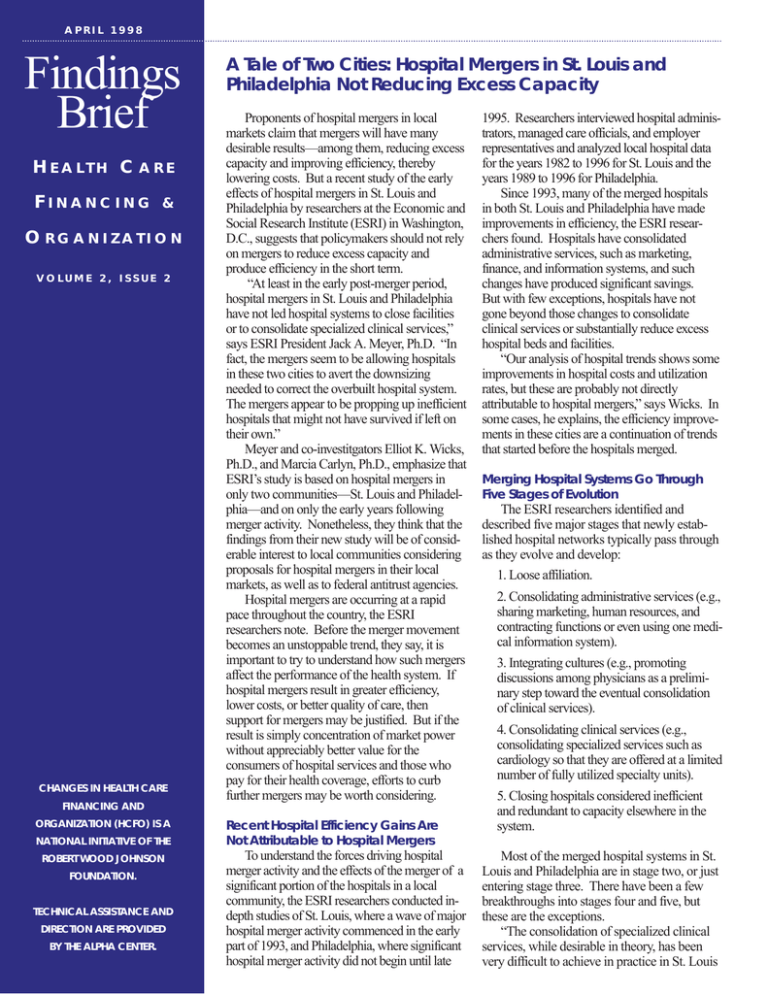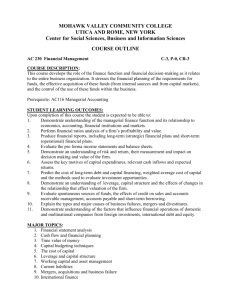Findings Brief A Tale of Two Cities: Hospital Mergers in St. Louis and Philadelphia Not Reducing Excess Capacity
advertisement

APRIL 1998 Findings Brief H EALTH F INANCING & O C ARE RGANIZATION VOLUME 2, ISSUE 2 CHANGES IN HEALTH CARE FINANCING AND ORGANIZATION (HCFO) IS A NATIONAL INITIATIVE OF THE ROBERT WOOD JOHNSON FOUNDATION. TECHNICAL ASSISTANCE AND DIRECTION ARE PROVIDED BY THE ALPHA CENTER. A Tale of Two Cities: Hospital Mergers in St. Louis and Philadelphia Not Reducing Excess Capacity Proponents of hospital mergers in local markets claim that mergers will have many desirable results—among them, reducing excess capacity and improving efficiency, thereby lowering costs. But a recent study of the early effects of hospital mergers in St. Louis and Philadelphia by researchers at the Economic and Social Research Institute (ESRI) in Washington, D.C., suggests that policymakers should not rely on mergers to reduce excess capacity and produce efficiency in the short term. “At least in the early post-merger period, hospital mergers in St. Louis and Philadelphia have not led hospital systems to close facilities or to consolidate specialized clinical services,” says ESRI President Jack A. Meyer, Ph.D. “In fact, the mergers seem to be allowing hospitals in these two cities to avert the downsizing needed to correct the overbuilt hospital system. The mergers appear to be propping up inefficient hospitals that might not have survived if left on their own.” Meyer and co-investitgators Elliot K. Wicks, Ph.D., and Marcia Carlyn, Ph.D., emphasize that ESRI’s study is based on hospital mergers in only two communities—St. Louis and Philadelphia—and on only the early years following merger activity. Nonetheless, they think that the findings from their new study will be of considerable interest to local communities considering proposals for hospital mergers in their local markets, as well as to federal antitrust agencies. Hospital mergers are occurring at a rapid pace throughout the country, the ESRI researchers note. Before the merger movement becomes an unstoppable trend, they say, it is important to try to understand how such mergers affect the performance of the health system. If hospital mergers result in greater efficiency, lower costs, or better quality of care, then support for mergers may be justified. But if the result is simply concentration of market power without appreciably better value for the consumers of hospital services and those who pay for their health coverage, efforts to curb further mergers may be worth considering. Recent Hospital Efficiency Gains Are Not Attributable to Hospital Mergers To understand the forces driving hospital merger activity and the effects of the merger of a significant portion of the hospitals in a local community, the ESRI researchers conducted indepth studies of St. Louis, where a wave of major hospital merger activity commenced in the early part of 1993, and Philadelphia, where significant hospital merger activity did not begin until late 1995. Researchers interviewed hospital administrators, managed care officials, and employer representatives and analyzed local hospital data for the years 1982 to 1996 for St. Louis and the years 1989 to 1996 for Philadelphia. Since 1993, many of the merged hospitals in both St. Louis and Philadelphia have made improvements in efficiency, the ESRI researchers found. Hospitals have consolidated administrative services, such as marketing, finance, and information systems, and such changes have produced significant savings. But with few exceptions, hospitals have not gone beyond those changes to consolidate clinical services or substantially reduce excess hospital beds and facilities. “Our analysis of hospital trends shows some improvements in hospital costs and utilization rates, but these are probably not directly attributable to hospital mergers,” says Wicks. In some cases, he explains, the efficiency improvements in these cities are a continuation of trends that started before the hospitals merged. Merging Hospital Systems Go Through Five Stages of Evolution The ESRI researchers identified and described five major stages that newly established hospital networks typically pass through as they evolve and develop: 1. Loose affiliation. 2. Consolidating administrative services (e.g., sharing marketing, human resources, and contracting functions or even using one medical information system). 3. Integrating cultures (e.g., promoting discussions among physicians as a preliminary step toward the eventual consolidation of clinical services). 4. Consolidating clinical services (e.g., consolidating specialized services such as cardiology so that they are offered at a limited number of fully utilized specialty units). 5. Closing hospitals considered inefficient and redundant to capacity elsewhere in the system. Most of the merged hospital systems in St. Louis and Philadelphia are in stage two, or just entering stage three. There have been a few breakthroughs into stages four and five, but these are the exceptions. “The consolidation of specialized clinical services, while desirable in theory, has been very difficult to achieve in practice in St. Louis APRIL 1998 and Philadelphia,” Meyer says. Several hospital system leaders in the two cities reported that this type of consolidation is often strongly resisted by senior medical staff trying to protect their “fiefdoms.” As of 1997, one merged hospital system in Philadelphia had consolidated at a single hospital some health services—obstetrics, behavioral health, and psychiatry— that were previously offered at three major hospitals. Some consolidation of these services was also occurring in St. Louis. “But both St. Louis and Philadelphia continue to have much excess capacity in their hospital systems in the early post-merger period,” Wicks observes. Hospitals Are Merging to Gain Market Share and Power in Negotiations with Health Plans The major impetus for many hospital mergers in St. Louis or Philadelphia is not the hospitals’ desire to operate more efficiently, Wicks explains. Rather, it is their desire to gain strength through size, improving their power in negotiations with health plans, in particular large managed care organizations. “We found that hospital mergers in both St. Louis and Philadelphia are preemptive actions to make hospitals less vulnerable to market pressures from health plans to cut costs,” Wicks adds. If hospitals have sufficient market clout, they can resist pressures by health plans to cut their rates. If they can hold the line on prices, they can avoid or postpone taking the painful steps to improve efficiency by closing facilities or consolidating clinical services. Mergers by suppliers (hospitals, physicians) and purchasers (health plans, insurers) have left both St. Louis and Philadelphia with only a few large players, producing a kind of equilibrium of buyers and sellers, says Wicks. “Health plans need the hospital systems in order to assure enrollees that they will have access to a large number of providers; and the hospital systems need the health plans to make sure that they have a patient base.” Intense negotiations between hospitals and health plans are confined mainly to prices, Wicks observes. “This leaves the underlying structure of the hospital system—and many of its entrenched inefficiencies—largely intact.” Employers and Other Large Purchasers Could Demand Reforms Concentrated hospital markets like those in St. Louis and Philadelphia—with three or four major merged hospital systems, a similar number of major health plans, and a number of large employer-purchasers—may not promote fundamental restructuring of hospitals, the ESRI researchers conclude. But employers and other large purchasers of health care coverage for individuals may be able to make a difference. “If employers and other large purchasers want a leaner and more efficient hospital industry,” says Meyer, “they will need to be less passive about the structure of that industry. They will need to use their market power to negotiate reductions in system-wide duplication and overlap.” Their options are either to negotiate directly with hospital systems or to contract selectively with health plans willing to choose fewer than all hospital systems for their networks. By taking one of these approaches, he thinks employers and other large purchasers could upset the equilibrium between hospital systems and managed care plans that is currently helping to maintain the status quo. Federal Antitrust Agencies Need to Guard against Anticompetitive Behavior At this point, the ESRI researchers say, it is hard to predict whether hospital mergers in local communities will ultimately result in a more efficient, rationalized system of fewer beds, consolidated clinical services, and fewer hospitals. In the long run, the outcome is likely to depend on the relative bargaining power of the merged hospitals as sellers on one side and the large employers and the health plans acting as their agents as buyers on the other. If the merged hospitals in a community are powerful enough to resist the efforts of the buyers, the local hospital economy may remain largely as it is—more concentrated but not more efficient. If the buyers get the upper hand, the hospitals may be forced to downsize, consolidate, and become more efficient. Noting the dramatic consolidation that is rapidly developing in the hospital industry across the country, the ESRI researchers suggest that the federal government needs to guard against anticompetitive behavior. “The prospect of large and medium-size market areas being dominated by as few as three major hospital systems—or even two—should lead the Federal Trade Commission and the U.S. Department of Justice to monitor those markets carefully to determine the consequences for the local health economy,” says Meyer. “Those federal agencies should establish clear criteria for determining whether meaningful competition exists and take remedial action when appropriate.” ■ For more information or for a copy of the report, contact Jack Meyer, Ph.D., or Elliot K. Wicks, Ph.D., at 202-833-8877. Findings Brief PAGE 2 “Hospital mergers in St. Louis and Philadelphia have not led hospital systems to close facilities or to consolidate specialized clinical services,” says ESRI President Jack A. Meyer, Ph.D. “In fact, the mergers seem to be allowing hospitals in these two cities to avert the downsizing needed to correct the overbuilt hospital system.” ALPHA CENTER 1350 CONNECTICUT AVENUE, NW SUITE 1100 WASHINGTON, DC 20036 TEL: (202) 296-1818 FAX: (202) 296-1825 Program Director ANNE K. GAUTHIER Deputy Director DEBORAH L. ROGAL Editor CAROLE C. LEE Writer KERRY B. KEMP






